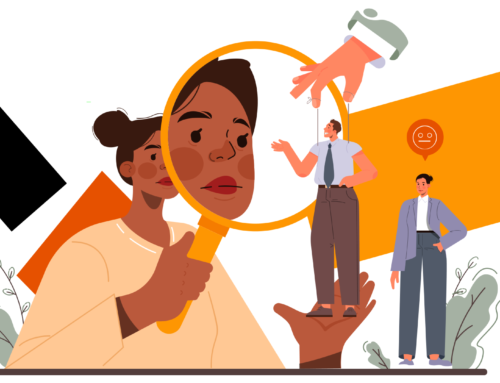Many people assume that some people are just born presenters. But we’re here to let you into a little secret – ANYONE can be a great presenter. And the best part? It isn’t even hard to do. It just takes a bit of preparation and practice. But where do you start if you’re really nervous? What do you need to practice? In this blog, we’ll examine the anxiety behind presentations, and also introduce you to the Trifecta of Effective Presentations: the skills, the tools, the content.
So, if you or a member of your team isn’t too keen on presentations, read on and find out what you can do to overcome your nerves.
The Physical Effect of Presentations
If you’re not someone who relishes the idea of presentations, you might be feeling your heart rate increase at the very thought of presenting. In fact, lots of people report feeling physically ill when they know they have to present. First, we want to reassure you that this is totally normal. The body is going into fight or flight mode; it is simply doing what it thinks it needs to do to protect you from a perceived threat.
So if you’ve found yourself sweating, shaking, or feeling nauseous before or during a presentation, there is absolutely nothing wrong with you.
Let’s say that again – there is absolutely nothing wrong with you.
And you’re definitely not alone – ask around, we bet you’ll find plenty of colleagues who feel the exact same (maybe even some of the people you consider to be ‘naturals’ at presenting). It’s also totally understandable that after feeling that way, you wouldn’t want to present again.
The good news is that those unpleasant sensations don’t have to be part and parcel of presenting. It is possible, with practice and support, to reach a point where these physical symptoms are far less intense, eradicated even.
How? Well, as unlikely as it seems, sometimes the best way to tackle anxiety and physical discomfort is to accept it, and examine it a bit closer. Often, when we start to feel uncomfortable, we focus on how to get rid of the sensation. We might rush through the presentation to get it done quicker, or even avoid giving a presentation at all costs!
Again, these responses are completely understandable and natural reactions to anxiety. But, they aren’t overly helpful long-term as they don’t help us address the root cause of the issue, or deal productively with the physical symptoms.
Instead, sometimes it makes sense to sit with what we’re feeling and just let it happen. We know, it’s not the normal advice you hear. But it is linked to another great tip for managing presentation nerves: breathe!
You might not realise it at the time, but what you’re doing when you breathe deeply to settle your nerves is you’re focusing on the here and now (a.k.a mindfulness). This practice of ‘mindfulness’ is fairly familiar in the modern day, and it is a great tool for understanding and addressing presentation anxiety.
Mindfulness is just one of a wide range of tools and methods available to help people get comfortable with presenting. And it’s one we love to use at Underscore during our presentation courses, along with insights from a form of therapy called Acceptance and Commitment Therapy (ACT).
ACT shares some similarities with mindfulness in that you don’t try and control your thoughts or feelings, you simply observe them. And once you become practiced at observing these sensations you can begin looking at alternative options for how to react in certain scenarios.
The key though, is knowing how to use these tools and techniques, and that’s where having a safe and supporting space is vital. Our Delivering Presentations with Impact course is an ideal place to start if you find you get nervous when presenting and want to understand why and how to address your nerves. We go into much more detail about the common causes of presentation anxiety, and help you learn, and importantly, practice, the tools that can help.
Using the right tools to look like a natural presenter
As we mentioned in the intro, there are three key elements to presentations – the skills, the tools, and the content. The skills are all about developing your confidence as a presenter (using tools like ACT and mindfulness). So what about the tools and the content?
We know that some people seem to have a natural talent for presenting, and it’s true that some people are simply more comfortable talking in front of a big crowd. But here’s another little secret for you: even the people who seem completely at ease when presenting need to practice and prepare for their presentations. They’ve just done it so much that they make it look effortless. And we promise, you can too!
The people who really excel at presentations have put a lot of thought into what they’re going to talk about and how they’re going to present it. Great presenters are also great storytellers, they don’t just think about the facts and figures they need to convey, but also come up with interesting narratives that take their audience on a journey. The use of anecdotes and personal insights is a great way to do this.
Also, they don’t wing it! The best presenters have played their slideshow over and over again and know with complete confidence what is on each slide, and have made great use of their chosen tool to display the relevant information.
And there is a lot that can be done with these tools, much more than most people realise. We all know the phrase ‘death by PowerPoint’ – it’s been used so much that people these days actually seem to be a bit afraid of using PowerPoint for fear of their presentation being labelled dull. But that’s unfair to this incredibly powerful tool, which, when used to its full potential can make a dry presentation engaging and informative.
So, we say don’t discount PowerPoint. Instead, why not learn how to use it the way it’s designed to be used. People who come along to our PowerPoint training sessions almost always leave loving the tool. They discover just how much it can do, and how quick it can be to set up fun and interesting presentations. From animations to automations, images to videos, there are lots of ways to present information in PowerPoint that people don’t even know about.
Plus, if you learn how to use all the snazzy shortcuts and clever tricks, you’ll instantly look like a PowerPoint pro, which will definitely help you feel more comfortable when delivering your . (Pro tip: if you’d like some support in learning all the features and functions available on PowerPoint, check out our PowerPoint – Professional Presentations course!)
What should I actually present?
So we’ve covered skills and tools. You’re feeling confident, you can manage your nerves, and you know that pushing ‘B’ when your slideshow’s running will black out the screen. You’re all set. Except…you don’t quite know what to include in your presentation.
This is where thinking like a trainer comes in handy. Qualified trainers, like our lovely Underscore team, spend a lot of time learning about how people learn, and what makes for good content.
The key here is that the presentation is not about you. It’s about your audience: what do they need to know? What will make the information interesting? How can you help ensure they remember it?
These are key questions that trainers have to consider when putting a course together, and they’re valuable principles for delivering presentations with impact too.
Firstly, no one wants to be bombarded with too much information. Our attention spans are limited; we’ll only absorb a little of what’s shown anyway. So it’s not worth your time to put every little detail into a presentation.
Instead, think about the key takeaways you want people to remember. For example, maybe you’re presenting induction training to new employees or teaching your colleagues how to use a new piece of software; what are the most important things they remember as a result? And what do you want them to do with that information when you’ve shared it? Is it just for their information, or do you want them to take action?
Once you know these things, be sure to make it clear in your presentation. Having a slide called ‘key takeaways’ or ‘next steps’ serve as great summaries for what you’ve covered and make it easy for people to hone in on the important bits.
It’s also great, where possible, to present key information in a range of different formats. This helps keep your training engaging. Think about how you can use images, videos, animations and even polls during your presentation. The more engaging and interactive you can make your presentation, the better people will remember it and absorb the information you’re sharing.
Another piece of advice is to plan ahead for any challenges. This could be anything from technology not working to someone asking a difficult question in your session. Or if you’re running a training session, you may have the odd difficult delegate attending; someone who doesn’t pay attention and keeps falling behind for example. While you can’t anticipate every scenario, it’s worth preparing for some of these – odds are they won’t happen, but you’ll be glad you did, if they come up.
In case of tricky technology, you could have back-up paper versions of your presentation available. To prepare for difficult questions, try and think what someone with no knowledge might ask – or get a friend to take a look and suggest some. And to prepare for difficult delegates, you could consider alternative training methods or exercises that might help them get their head around it.
It might seem like there’s a lot to learn about what to include in your presentation, but remember, this is a journey. Every time you present you will improve. You’ll learn a valuable piece of information that you can apply next time. And if you want to give yourself an advantage, it’s well worth checking out our Train the Trainer course. It covers a lot of what we’ve just discussed and a lot more, and it can be applied in lots of different settings, whether you’re developing a presentation, or helping a new team member get settled into their new role.
We hope you’ve found some of our tips useful. In truth, we’re just scratching the surface. There are so many ways you can learn to become a ‘natural’ presenter, but the single most important thing is to keep practicing!
If you or your team could benefit from presentation skills training, talk to us today – training@underscoregroup.com and we’ll help you Master the Trifecta of Effective Presentations.







Hello underscore-group.com owner, Thanks for the well-written and informative post!